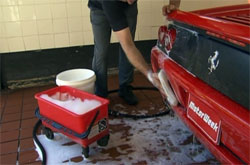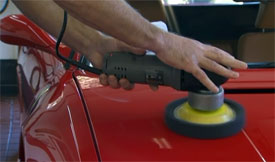Detailing Tips
We love it when our cars look shiny and new. But over time our daily drivers are subjected to lots of damage from the sun, dirt and smog. So, what can you do to keep up your vehicle's appearance over the long haul? Well, Pat Goss has the details on successfully detailing your car.
PAT GOSS: Keeping your car looking good means it's going to maintain its value better, and it's just going to be more fun to drive. And here to give us some tips we have Mike Lambert from The Shine Shop here in Reisterstown, Maryland. Mike, welcome to Goss' Garage.
MIKE LAMBERT: Nice to be here, Pat, thank you.
 PAT GOSS: Ok, you have five steps in your process, tell us about them.
PAT GOSS: Ok, you have five steps in your process, tell us about them.
MIKE LAMBERT: We have washing, cleaning, polishing, protecting, and maintaining.
PAT GOSS: Alright, let's start with washing. What do we need to know there?
MIKE LAMBERT: We should use two buckets at a minimum, both with brick guards, which will protect your wash mitts from bringing dirt off your car in. One strictly for the tires and the wheels and the bottom part of the car, which is the dirtiest, and the other for your clean wash water with your quality car wash in it.
PAT GOSS: Ok, now, read and follow label directions. More is not better.
MIKE LAMBERT: Absolutely.
PAT GOSS: And dishwashing detergent and all that stuff.
MIKE LAMBERT: No, it will take the grease off a plate, it will take the wax right off your car.
PAT GOSS: Ok. Step number two.
MIKE LAMBERT: We're going to clean the car with a clay bar, which is very easy for anybody to do, using a quality spray detailer and a microfiber towel.
PAT GOSS: Alright, and a lot of people seem to think that using clay on a car is this monstrous job; it really isn't.
MIKE LAMBERT: Absolutely not. It will do wonders for the rate that your wax will last, and it will make the shine on the car look better because the paint will be smooth as glass.
PAT GOSS: Ok. Next.
MIKE LAMBERT: We're going to polish the car with a good quality polish, using microfiber products again. That will remove any of the minor surface blemishes, scratches and also nourish the paint.
 PAT GOSS: Alright now, people have to realize that polish is not wax, and wax is not polish.
PAT GOSS: Alright now, people have to realize that polish is not wax, and wax is not polish.
MIKE LAMBERT: No. Polishing just brings out the shine of the car, waxing is for protection only.
PAT GOSS: Ok. And you mentioned microfiber, uh, no terry towels or anything like that.
MIKE LAMBERT: Microfiber will pull the product you're using or the dirt off of the car. Um, terry cloth towels, wipers, things of that nature just grind it right back into it.
PAT GOSS: Oh, interesting, ok. What's next?
MIKE LAMBERT: Uh, we're going to maintain the car, which is regular washing. And when you dry the car, a good tip is to use a spray detailer and the microfiber drying towel. That will also minimize any scratching.
PAT GOSS: Now how often should we wax it?
MIKE LAMBERT: I would say at least a minimum of every six months, a good polish or wax every six months if your car is outside. If your car's garage kept and you maintain it very well, washing it frequently, uh, once a year a real job polish and a wax.
PAT GOSS: Ok now, finally, old cars, new cars, differences between the paint.
MIKE LAMBERT: Uh, old cars a single-stage paint. Uh, that means you're working directly on the color of the car. On the newer cars there's a clear coat over your color, you're working on a clear surface. Be a little more gentle on the paint, because you are removing the paint itself.
PAT GOSS: And if you go buy a new car you're apt to come up against a sales person that is going to tell you that the car never needs to be waxed, or they can sell you a product that means it will never need to be waxed.
MIKE LAMBERT: Regular maintenance is the key as it is mechanically. You'll be able to see any damage done to your paint: scratches, chips, anything like that need to be repaired. And if you notice, they all need to be reapplied at least once a year.
PAT GOSS: Ah-ha. Ok, Mike thank you so much.





